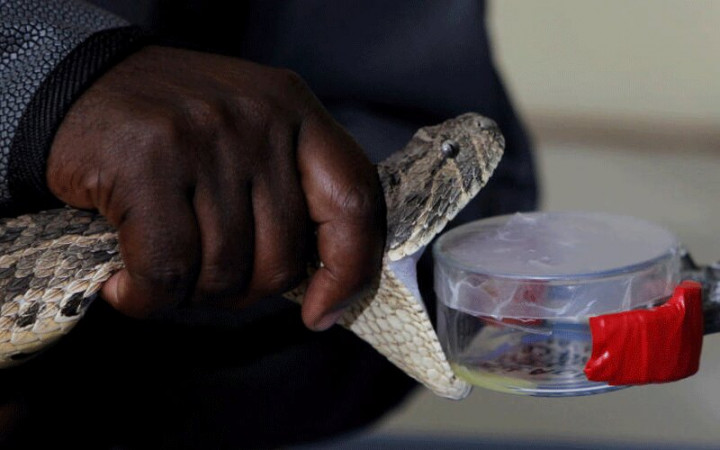Biting shortage of snake poison drugs in Kenya

Local researchers are racing against time to address an acute shortage of anti-venoms in the wake of increasing cases of snake bites in Kenya.
Available data indicates that the number of people bitten by snakes had increased from a paltry 87 to 19,163 in three years, between 2015 and 2018.
As the world marks the International Day of Snakebites today, it is estimated that between 15 and 25 Kenyans die daily due to snake envenomation, and more than 100 others lose their limbs through amputation. These cases coincide with dwindling stocks of anti-snake venom drugs in many public health facilities.
Reports from across the country paint a grim picture of patients being turned away due to lack of anti-venoms and, in extreme circumstances, people dying after being bitten by snakes.
However, a collaborative effort of the Ministry of Health and research scientists in various government institutions, such as the Institute of Primate Research (IPR) and the National Museum of Kenya (NMK), is offering a glimmer of hope to people living in snake-infested areas.
Counties with high prevalence of snakebites in Kenya include Kajiado, West Pokot, Turkana, Narok and Baringo, where between 60 and 120 people per 100,000 residents are bitten by snakes annually.
Researchers expect the collaboration to start bearing results in the next five years.
The government has entered into an agreement with countries such as Costa Rica that are more advanced in anti-snake venom research and production, with an aim of producing anti-venom serum suited to the type of snakes found in Kenya.
“We will have a newer generation of anti-venoms soon to address the current deficiencies,” Dr George Omondi, head of Kenya Snakebite Research and Intervention Centre (KSRIC) told ‘People Daily’.
To enhance education and behavioural change by people bitten by snakes to seek treatment in hospitals, IPR has requested Kenya Medical Supplies Authority (Kemsa) EMSA) to stock two anti-venom serums.
These are expected to replace two other anti-venom serums — VINS Snake Venom Antiserum and Inoserp Pan-Africa® injection — that Kenya has been importing from India and Mexico, respectively.
“Three weeks ago, the World Health Organisation wrote to Kenya through the Pharmacy and Poisons Board, asking for withdrawal of the two anti-snake venom products because their manufacturers were not following good practices,” Dr Omondi said, adding that this was one of the reasons Kenya was fast tracking production of its own anti-venom serums.
Geographical variations
“The two products were found not to be efficacious enough, prompting the government to enter into agreements with Mexico and Costa Rica, for new imports which are thought to be more potent due to their geographical variations including toxicity and protein content,” he pointed out.
Omondi added that plans are at an advanced stage to use camels, baboons and cows to produce anti-snake venom drugs. He revealed that, traditionally, only horses and sheep have been used for harvesting of antibodies that are eventually separated to produce anti-venom serum.
“However, because of the deficiencies that are inherent with antibodies produced by these animals, we are trying to introduce other animals such as camels and cows because they have special characteristics in their antibodies that can treat snake bites more effectively,” he said.
“The progress is good,” he noted, revealing that a recently-signed memorandum of understanding with Costa Rica would enable Kenya to set up a Sh100 billion facility for packaging anti-venom serum.
The plan, according to Omondi, is to milk the venom and send it to the company in Costa Rica, which will then immunise their animals for extraction of antibodies. The firm will then send the anti-venom drugs to Kenya. “The venom is introduced to an animal by a process called immunisation, that raises the animal’s antibodies. Scientists then harvest antibodies by drawing blood from the animal. The antibodies are separated and produced by Big Pharma for mass use,” he said.
Dr Omondi disclosed that cleaning of the antibodies for snake antiserum is costly, adding that it makes economic sense for Kenya to have its own manufacturing plant. “It costs Sh10, 000 to produce one vial and one snake bite patient requires three to five vials to be treated,” he said.
In Kenya, out of the 140 known snake species, 29 are venomous. Of these, only 13 are of medical importance as their venoms cause injury or death. But, he said, by the end of the year, the country should be able to obtain data from 15 counties that bear the biggest burden of snake bites.
Dr Kinyatta Malonza, a senior researcher at the herpetology division, NMK, says the country is facing an acute shortage of anti-snake venom drugs, particularly in remote areas. “They are only available in a few selected hospitals. Currently, we do not have a locally made anti-venom. It is critical to purchase enough and distribute it; more importantly to train health workers on how to administer it,” he said.
According to Dr Wyckliff Omondi, the head of the division of Vector-borne and Neglected Tropical Diseases (NTD) at MoH, his department, together with KSRIC and other stakeholders, is training local personnel to manage the proposed manufacturing plant which should be operational in three years.
“We shall make our own anti-venom when we acquire advanced skills and knowledge like Costa Rica. Anti-venoms are specific to various regions, so if you try to use a black mamba anti-venom from South Africa or India, sometimes it may not be very effective,” he said.
And Dr Sultan Matendechero, head of Kenya National Public Health Institute/ Centres for Disease Control and Prevention (NPHI/CDC), snake bite treatment has gained momentum since 2018 when guidelines were developed and three new anti-venoms registered.
“Training of health workers on the administration and sensitisation of community members to regain confidence in hospitals has also taken place,” he said.
The WHO prioritised snake-bite as an NTD in 2017 and encouraged policymakers to take it more seriously. The initiative led to Kenya receiving financial support from the UK’s National Institute for Health Research to set up KSRIC.
Studies show that up to 85 per cent of snake bite victims in Kenya seek treatment from traditional practitioners or use rudimentary means to eliminate the venom.












